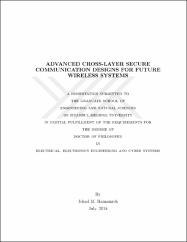| dc.contributor.advisor | Arslan, Hüseyin | |
| dc.contributor.author | Hamamreh, Jehad Mahmoud Amin | |
| dc.date.accessioned | 2021-06-28T08:52:35Z | |
| dc.date.available | 2021-06-28T08:52:35Z | |
| dc.date.issued | 2018 | en_US |
| dc.date.submitted | 2018-07 | |
| dc.identifier.citation | Hamamreh, J. M. A. (2018). Advanced cross-layer secure communication designs for future wireless systems. (Unpublished doctoral thesis). İstanbul Medipol Üniversitesi Fen Bilimleri Enstitüsü, İstanbul. | en_US |
| dc.identifier.uri | https://hdl.handle.net/20.500.12511/7336 | |
| dc.description.abstract | Due to the inherent vulnerability of wireless transmission to eavesdropping, con- dentiality arises as a challenging issue especially for future wireless networks because of their unique requirements. To cope with this, physical layer security (PLS) has emerged as a new concept and prospective solution that can complement and even replace encryption-based methods, which entail many practical problems that may impede its implementation and adoption in future wireless networks. To address this challenge, in this thesis, novel, advanced and cross physical (PHY) and media access control (MAC) layer security designs are developed for providing con dentiality against eavesdropping in future wireless networks. The conducted research studies encompass the following main approaches. I) Cross PHY/MAC layer security techniques using: 1) Automatic-repeat-request (ARQ) with maximal ratio combination (MRC) and adaptive modulation; 2) ARQ with MRC and null-space-independent arti cial noise. II) Security techniques for orthogonal frequency-division multiplexing (OFDM)-based waveforms. This includes developing new designs that cover the following topics: 1) OFDM with adaptive interleaving and precoding. 2) OFDM with subcarrier index selection for enhancing security and reliability of 5G services. 3) Cyclic pre x (CP)-less OFDM with alignment signals for enhancing spectral e ciency, reducing latency, and improving PHY security of 5G and beyond services. III) New inherently secure waveform designs, where a secure channel-based transform waveform, referred to as orthogonal transform division multiplexing (OTDM) waveform, is developed and proposed for future 5G wireless systems. Then, its time-frequency characteristics are investigated along with devising a method to reduce its peak to average power ratio. IV) Security designs for orthogonal space-time block coding (OSTBC)-based multi-input-single-output (MISO) systems, where precoding matrix indicators (PMI) are utilized and redesigned for providing secrecy. | en_US |
| dc.description.abstract | Kablosuz iletimde gönderilecek bilginin gizlice dinlenebilmesi, farklı ihtiyaç gereksinimlerini sahip gelecekteki haberleşme sistemleri için iletim güvenirliliğini zorlu bir sorun olarak ortaya çıkarmaktadır. Bununla başa çıkmak için fiziksel katman güvenliği (PLS) güçlü ve ileriye dönük yeni bir çözüm olarak ortaya çıkmıştır. Bu yöntem gelecek haberleşme sistemlerinde uygunabilirlik açısından problemler oluşturabilecek şifreleme tabanlı yöntemleri tamamlayabilir, hatta yerini alabilir. Bu zorluğu çözmek için, bu tezde özgün ileri ve çapraz PHY/MAC katman güvenlik tasarımları gelecek haberleşme sistemlerinde gizlice dinlenilmeye karşı güvenirliliği artırmak için geliştirildi ve önerildi. Yapılan araştırma çalışmaları aşağıdaki ana yaklaşımları kapsamaktadır. I) Çapraz PHY/MAC katman güvenlik teknikleri: 1) Maksimum oran kombinasyonu (MRC) ve adaptif modulasyon ile otomatik- tekrar-istek (ARQ) ; MRC ve boşluk uzayından bağımsız yapay gürültü ile ARQ. II) OFDM tabanlı dalga formları için güvenlik teknikleri. Bu aşağıda başlıkları içeren yeni tasarımlar geliştirmeyi içerir: 1) Uyarlamalı serpiştirme ve ön kodlama ile OFDM. 2) 5G URLLC hizmetlerinde güvenlik ve güvenirliliğin artırılması için alt taşıyıcı indeks seçimi ile OFDM. 3) Spektral verimliliği artırmak, gecikmeyi azaltmak ve PHY güvenliğini geliştirmek için hizalama sinyalleri ile ön-eksiz (CP-less) OFDM. III) Dikgen dönüşüm bölmeli çoğallama (OTDM) olarak adlandırılan güvenli kanal tabanlı dönüşüm dalga form tasarımları gelecek haberleşme sistemleri için geliştirildi ve önerildi. Daha sonra, bu dalga formunun zaman-frekans karakteristiği incelendi, zirve ve ortalama güç oranını (PAPR) düşürmek için bir metot geliştirildi. IV) MISO tabanlı dikgen uzay-zaman blok kodlamalı (OSTBC) sistemler için ön gösterge matris göstergelerinin (PMI) kullanıldığı ve yeniden tasarlandığı güvenlik tasarımları. | en_US |
| dc.language.iso | eng | en_US |
| dc.publisher | İstanbul Medipol Üniversitesi Fen Bilimleri Enstitüsü | en_US |
| dc.rights | info:eu-repo/semantics/openAccess | en_US |
| dc.subject | Physical Layer Security | en_US |
| dc.subject | OFDM | en_US |
| dc.subject | STBC | en_US |
| dc.subject | ARQ | en_US |
| dc.subject | MRC | en_US |
| dc.subject | MAC | en_US |
| dc.subject | Fiziksel Katman Güvenliği | en_US |
| dc.subject | OFDM | en_US |
| dc.subject | STBC | en_US |
| dc.subject | ARQ | en_US |
| dc.subject | MAC | en_US |
| dc.subject | PHY | en_US |
| dc.title | Advanced cross-layer secure communication designs for future wireless systems | en_US |
| dc.title.alternative | Geleceğin kablosuz sistemlerinde katmanlar arası ileri güvenli haberleşme tasarımları | en_US |
| dc.type | doctoralThesis | en_US |
| dc.department | İstanbul Medipol Üniversitesi, Fen Bilimleri Enstitüsü, Elektrik ve Elektronik Mühendisliği ve Siber Sistemler Ana Bilim Dalı | en_US |
| dc.relation.publicationcategory | Tez | en_US |


















